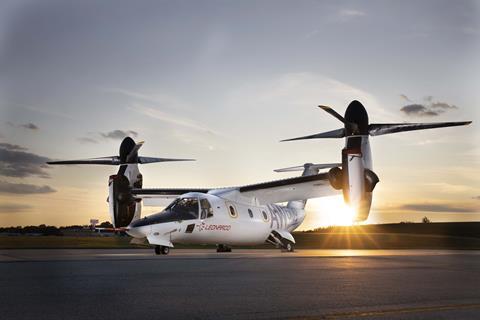Leonardo Helicopters believes its AW609 civil tiltrotor remains on track to secure US certification next year following a series of recent interactions with Federal Aviation Administration (FAA).
Matteo Ragazzi, senior vice-president of engineering and innovation at the airframer, highlights the “increasing pace of execution” at the FAA, which is now “delivering results”.

Ragazzi, speaking to FlightGlobal on 6 November at the European Rotors show in Amsterdam, said the airframer is seeing “tangible progress” towards type certification.
“The FAA team is providing tangible deliverables to enable execution at the moment,” he says.
On 31 October, the FAA agreed the final certification basis for the tiltrotor, which Ragazzi says is identical to the draft version Leonardo has been working towards for several years.
Based on recent agreements with the FAA, Ragazzi is confident that the critical Type Inspection Authorization (TIA) – marking the formal start of certification flight tests – will be received in the first quarter of 2025.
Although a “more aggressive” timeline had been hoped for, gaining approval for certain suppliers has required additional time and “one or two more flights”.
However, all company certification flight testing was completed “last week”, he adds.
Assuming the TIA is granted in line with expectations, Ragazzi anticipates type certification can “absolutely” be obtained for the AW609 next year.
The agreement of the certification basis builds on other recent activities with the FAA. In late September, the regulator and airframer held a three-day meeting in New York attended by 80 people to review the certification process.
Convening a so-called “interim type board” (ITB) is a definite indication of progress, he argues: “The FAA doesn’t call an ITB if it is not seeing the data it deserves.”
Leonardo Helicopters’ cause has also been aided by the FAA’s publication last month of its special federal aviation regulation (SFAR) for ‘powered lift’ aircraft, which sets out the operational and training requirements for this new category of aircraft, including the AW609.
Agreement of the SFAR was “pivotal”, argues Ragazzi, providing clarity for operators and the wider industry.
Leonardo Helicopters is also pursuing European Union Aviation Safety Agency (EASA) certification for the tiltrotor and anticipates receiving certification basis from the regulator by year-end, leading to approval in the 2026-2027 timeframe.
Ragazzi expects minor differences between the EASA and FAA requirements but says these will be “manageable within the existing design”.
EASA pilots have been flying the AW609 since March 2023 and completed another round of familiarisation activities in September, he adds.
Two prototypes – aircraft 3 and 5 – are currently in the USA, while aircraft 4 is in Italy. The US fleet will next year gain the initial production aircraft, leading to the retirement of aircraft 3.
Currently in final assembly at Leonardo’s Philadelphia plant – power-on is scheduled for year-end – the first serial AW609 will be used for FAA function and reliability testing. An additional three examples are in various stages of production.
The AW609’s path to certification has been a lengthy and complex one: development began in the late 1990s and the tiltrotor first flew in 2003. Initially a co-development with Bell, the US airframer sold its interest in the programme in 2011.
Flight-testing was also set back by a fatal crash in October 2015.
Meanwhile, Italian government agencies are contemplating a second round of demonstration flights, following a previous phase earlier this year that saw the AW609 operate from the navy’s flagship, the aircraft carrier ITS Cavour.
Possible roles include long-range patrol and surveillance operations for the Guardia Di Finanza, or logistics missions for the navy.
Sales of the AW609 have so far been modest: just five firm orders have been booked to date.
But Stefano Villanti, senior vice-president of marketing and sales, believes the tiltrotor’s time will come, even if its initial introduction may be more gradual than that of a conventional helicopter.
“I think it’s the start of a new family of products that might change the market dramatically,” he says.
“My belief is that the architecture and capability it offers are ground-breaking so the market potential could be quite big – much bigger than people expect.”



















































